Arts
Yahaluwo (Friends)
Boiling ethnic cauldron through the eyes of a child :
by Ranga Chandrarathne
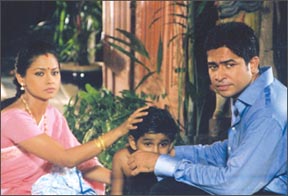 Yahaluwo, the latest film by veteran filmmaker Sumithra Peiris
depicts Sri Lankan society in a miniature form within confines of a
house and through the eyes of a child who symbolizes the hapless third
generation which is bequeathed with the legacy of division, ethnic
hatred and ethnicities in conflict with one another. Yahaluwo, the latest film by veteran filmmaker Sumithra Peiris
depicts Sri Lankan society in a miniature form within confines of a
house and through the eyes of a child who symbolizes the hapless third
generation which is bequeathed with the legacy of division, ethnic
hatred and ethnicities in conflict with one another.
The story takes place within confines of a house where a child of
mixed parentage (Rajive) grows amidst ethnically heterogeneous servants.
Rajive is a middle-class boy from Colombo. His mother, Manorani, is a
doctor and his father Asoka, is a very successful businessman. As his
younger brother dies prematurely, he is left with servants at house.
As the parents leave, Rajive starts to explore life involving in love
and hatred of his ethnically heterogeneous servants. He gradually comes
to terms with grim reality of the world outside the confines of the
house through the disturbing ethnic relations of his servants. Through
his Bugher teacher of music, Rajive learns that minority ethnic
community had to leave the country due to language issue.
|
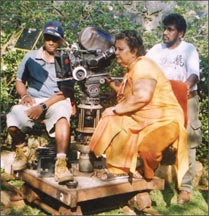
Veteran filmmaker Sumithra Peiris |
As the tremor of ethnic tension begins to affect personal
relationship with Rajive's Tamil grandparents who take a painful leave
to Canada. The separation was painful for both Rajive and the
grandparents. However, it was alleviated by his Sinhalese grandmother,
Mrs. Nugawela who helps him to recover from the deprivation of his
grandparents.
Rajive demands justice and humanity when problems between Sinhalese
driver Jinadasa and Tamil gardener Thotayyah disrupt the ethnic harmony
of his house. The Tamil Gardner is always at loggerhead with
chauvinistic Sinhalese driver brilliantly portrayed by Kamal Addarachchi,
though plays on a lighter tone, carrying a deeply-entrenched organic
ethnic hatred of a linguistically segregated generation.
It is this hatred which is from time to time flared by generation of
shrewd politicians often in the hide of patriotism. Sinhalese driver has
a kind of romantic feelings towards Muslim servant and the intermediary
between them often becomes the child.
Though with a light heartedness to the very core of the film, it is a
serious story narrated through the eyes of a child. Each and every
character is well delineated to represent diverse ethnic identities and
dominant dogmas.
For instance, the character of the teacher of Sinhalese is erupted
when the little boy questions how his mother tongue being Sinhalese
while having a Tamil mother. The teacher of Music who is a Burgher
reveals another facet of the history of the country and its short-sighed
language policy. Ms. Jansz describes how Burhers had to leave the
country as they were unable to teach in Sinhala.
At the end, Rajive who is sandwiched between, conflicting servants
plea for social justice, humanity and for equality for all the
ethnicities. It is the plea of the third generation who grew with this
horrible nightmare which we are living in.
One of the salient aspects of the film is its contemporaneous which
is amply manifested through animal kingdom at the house and the child
mimicking the role of Sanath Jayasuriya in playing cricket with his
servants.
Himasal Thathsara Liyanage as Rajive (Son) brilliantly portrayed the
main role and he is supported by Sujeewa Senasinghe, a new comer to the
field of cinema, who also showed aptitude in portraying the character of
Asoka (Husband) while Pooja Uma Shankr, plays her real ethnic role as
Manorani with her own voice which will certainly infuse credibility into
the character.
For most of the roles, genuine ethnic actors have been used adding
coloure to the film. Vasanthi Chaturani as teacher of music depicts her
role convincingly with much gusto while rendering her voice for the
background song. Kamal Addarachihi who plays the role of Wijepala- Gate
Keeper, shows his inherent talents in depicting a role of a romantic
youth who tries to tie up with servant Noorie played by Gangu Roshana.
The film, though in a minuscule scale, explores diverse issues
confronting contemporary Sri Lankan society and would be enrichment for
deserving children and adult souls who have not corrupted their minds
with hair-splitting dogmas. It strives hard to drive home the truth that
humanity knows no boundaries and divisions although we are all clad in
different cultures and that the doors are open for all to live life as
members of the human family.
The film will be outstanding in music as perhaps for the first time,
Pandith W.D. Ameradeva and Arundathi Sri Ranga Nadan presents a duet and
the music for the film is directed by veteran musician Navaratne Gamage.
Art Director Gayatri Mustachi and K.A Dharmasena (Photography) have also
contributed to make "Yahaluwo" a colourful venture.
[email protected]
Pulimood Oration
by Ranga Chandrarathne
|
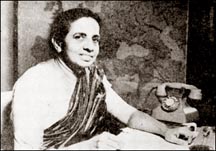
Susan George Pulimood |
Seventeenth Susan George Pulimood Oration will be delivered tomorrow
by veteran poet, short story writer, novelist and academic Sita
Kulatunga on 'Creative Writer and Social Change'. Mrs. Pulimood, an
outstanding principal of Vishaka Vidyalaya, was an impressive
personality. It will also mark the hundredth birth day of Susan Pulimood.
Mrs. Sita Kulatunga met Mrs. Pulimood at the selection test at
Vishaka Vidyalaya which was personally conducted by Mrs. Pulimood. Mrs.
Pulimood dressed well and the Saris she wore suited her very well.
As Vishaka is considered as a girls school which prepared good future
wives for upper middle class men, Mrs. Pulimood had done much to change
this tradition and she had the vision of what kind of role women asked
to play decades ahead of her time.
|
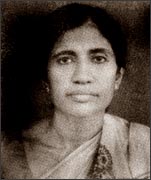
Sita Kulatunga |
Accordingly she strengthened Science Stream resulting in producing
large number of professionals such as doctors, engineers and scientists
who work all over the world.
She was a botanist and authored a botany book for Advanced Level
Bio-Science stream and was a must at the time. Her other love was
literature. Commenting on the oration, Sita Kulatunga stated that the
lines in journalistic writing verges on creative writing.
Element of creativity is found in journalistic writing of authors
such as Arundathi Roy. Even in the Independent struggle, the propaganda,
especially by Anagarika Dharmapala and Piyadasa Sirisena worked both as
journalistic writings. They converted Ceylonese women from Western dress
to Sari and Kandyan Sari. T. G. W. de Silva criticised the Western
attire.
A city of vintage tune
|
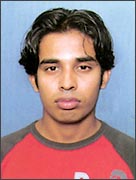
S. Nuwan Nalaka |
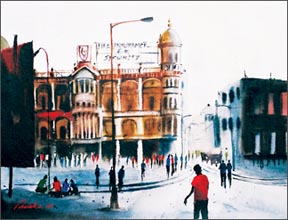 The second solo exhibition of water colour paintings by the young
artist S. Nuwan Nalaka will be held at the Indian Cultural Centre from
July 25-28, 10.00 a.m. - 6.00 p.m. On July 25 the opening day, the
exhibition will be from 6.00 p.m. The second solo exhibition of water colour paintings by the young
artist S. Nuwan Nalaka will be held at the Indian Cultural Centre from
July 25-28, 10.00 a.m. - 6.00 p.m. On July 25 the opening day, the
exhibition will be from 6.00 p.m.
The exhibition is titled Kolkata - A City of Vintage Tune and Nuwan
Nalaka's twenty exhibits depicts Kolkata as a city of joy. "I've tried
to capture the vintage essence of the oldness like in the house of
colonial design, the extraordinary Ionic Gothic and Corinthian columns
of architecture.
My last exhibition portrayed the social and political aspects of
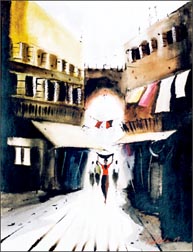 Kolkata life. In this year's exhibition I'm depicting the spirit of the
city life - the cars, taxis, autos, rickshaw pullers and the market
place," says Nuwan Nalaka. Kolkata life. In this year's exhibition I'm depicting the spirit of the
city life - the cars, taxis, autos, rickshaw pullers and the market
place," says Nuwan Nalaka.
Influenced by the impressionist painters he has mastered the
transparent water colour technique which is reflected in the colour and
light strokes. A student of the Gampaha Bandaranayake College, Nuwan
after his A Levels joined the Rabindra Bharathi University, Kolkata to
further his technique and to achieve the Master of Visual Art.
Next year he says he intends having two solo exhibitions, one in Sri
Lanka and the other in India.
M.P.
|
